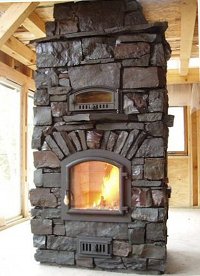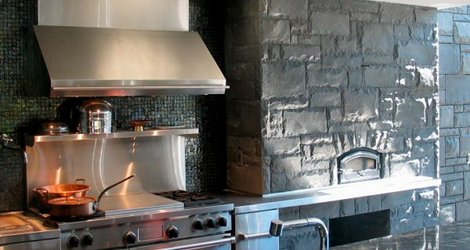
So what is a contraflow fireplace? Who knows how to build one? Not me as of yet. The idea sounds interesting, though. With a huge pile of bricks in my front yard, I started my research.
Turns out the idea, although it carries a very long and distinguished history, dovetails neatly with today’s green revolution. The northern European countries and Russia have been using masonry stoves for years since the 17th and 18th centuries, when kings in Prussia and Scandinavia ordered their craftsman and architects to produce better wood stove designs.
This concerted effort produced radically new heat-storing masonry stoves, which showed enormous improvement in efficiency and wood conservation.

Fast-forward to today, when masonry heaters are still in widespread use throughout northern Europe and are highly regarded for their excellent heating abilities, safety, and environmentally positive aspects. Countries such as Germany, Austria and Switzerland use the “kachelofen” or tile stoves, which are so popular that buying one can require a one-year wait.
In North America, our heating traditions unfolded differently, where an abundance of available, relatively cheap fossil fuels led to more widespread use. As a result, gas, oil, and electricity still have the lion’s share of the residential heating market (and the industry marketing budgets spend millions of dollars to keep it that way).
During the North American energy crisis of the 70s, many people turned to wood stoves to cut their heating bills. Environmental and economic concerns of the last decade have forced a critical look at better wood-heating devices. If we’re going to get this right ecologically, the stoves have to be efficient more efficient than typical metal-clad stoves.
How energy efficient are today’s masonry stoves? They are proving to be the cleanest method of burning wood, because the wood burns very hot and quickly, producing little or no smoke, soot, or creosote. When wood burns at 1100ºF, everything that can be burned is consumed. The secondary combustion chambers in masonry stoves reach temperatures of 1400º-1800ºF, and well over that point.
After the quick-burning but intense fire has gone out, the energy stored in the massive bulk of masonry is released slowly into the house over the succeeding 18 to 24 hours. Various forms of biomass heating, including masonry stoves, are getting a lot of attention from ecological architects and designers today.
If you’re considering a masonry stove, you can take one of three approaches: ready-made product, stove kits, or custom design. But first, be prepared for a long-term investment. The better-known soapstone fireplaces from Tulikivi will set you back anywhere from $7,500 to $10,000. Temp-Cast build-it-yourself stove kits start at about $3,500; then add another few thousand for professional installation.

The Masonry Heater Store in Holland, Ohio designs and installs custom masonry, which is a beautiful way to make the hearth the heart of your home. In talking with co-owner Nancy Matesz, I learned that business is brisk in their corner of the world. She said, “As the environmental and cost advantages of masonry are becoming more understood, our business is really growing. Whether we’re doing a custom design or installing a Tulikivi, we hear the same message from our customers–they like the security of protecting themselves against skyrocketing fuel costs.”
Like many decisions that support a more sustainable world, an investment in a masonry stove saves money. Then, as a bonus, add a pizza or bread oven to keep your buns warm.